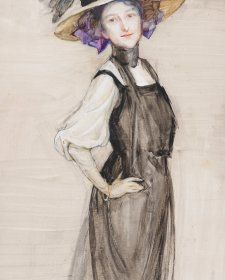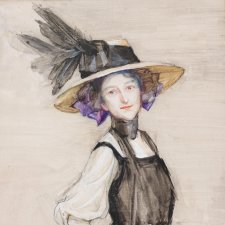- About us
- Support the Gallery
- Venue hire
- Publications
- Research library
- Organisation chart
- Employment
- Contact us
- Make a booking
- Onsite programs
- Online programs
- School visit information
- Learning resources
- Little Darlings
- Professional learning
Harold Parker (1873–1962), sculptor, was born in Buckinghamshire but grew up in Brisbane, commencing his training in art at the Brisbane Technical College in the late 1880s. Having spent a year in Sydney, where he made carved furniture for the NSW Forestry Commission’s contribution to the 1893 Chicago Exhibition, Parker left for London. He studied sculpture at the City and Guilds of London Technical Art School and worked as an assistant to a number of prominent practitioners. A regular exhibitor at the Royal Academy from 1903, Parker produced sculptures of classical and mythological figures in marble and bronze as well as memorial sculpture, portrait busts and reliefs. His Ariadne was acquired for the Tate in 1908; and he was awarded medals for the sculptures he exhibited in the Paris Salons of 1908 and 1910. In 1915, he started work on his most significant public commission – the large sculptures Prosperity and The Awakening of Australia for the entrance to Australia House in London, which were completed in 1918. In 1930, Parker returned permanently to Australia with his wife, Janet, whom he had married in London in 1911. He held solo exhibitions of his sculptures and watercolours in Sydney and Melbourne in the early thirties, and in 1938, his works The Pioneer and Eve repentant were exhibited in the sesquicentenary ‘All Australian Art Exhibition’ at the Art Gallery of New South Wales. Though relatively few of Parker’s works were acquired by Australian institutions during his lifetime, examples now reside in collections such as that of the University of Queensland, which also holds his personal papers. This miniature is believed to have been painted by Bessie Gibson (1868–1961), an Australian painter who, like Parker, grew up in Brisbane but lived and worked abroad for many years. Born in Ipswich, Gibson studied art at Brisbane Technical College and in 1905 left Australia for further study in Europe. She ended up staying for more than forty years, exhibiting regularly at the Société des Artistes Français and the Salon d’Automnes in Paris, where she lived, and at the Royal Academy.
One of a small group of Australian women artists, including Bess Norriss Tait, associated with the brief re- emergence of the portrait miniature in the early twentieth century, Gibson’s output also included formal portrait commissions, landscapes, interiors and still life. She returned to Australia after World War II and continued exhibiting during the 1950s and 60s. The Queensland Art Gallery staged A Tribute to Bessie Gibson in 1958.
Gift of Rosamond Shepherd 2010. Donated through the Australian Government's Cultural Gifts Program.
Ros Shepherd (1 portrait)



On one level The Companion talks about the most famous and frontline Australians, but on another it tells us about ourselves.



Bess Norriss Tait created miniature watercolour portraits full of character and life.



Spanning the 1880s to the 1930s, this collection display celebrates the innovations in art – and life – introduced by the generation of Australians who travelled to London and Paris for experience and inspiration in the decades either side of 1900.